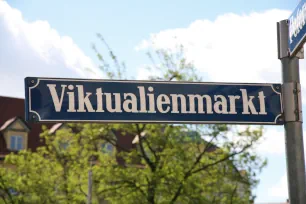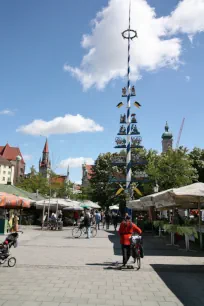Established in 1807 by decree issued by Maximilian I, Viktualienmarkt (literally, victuals market) was built to replace a much smaller market that had once served the needs of the burgeoning city of Munich.
History

The small central market at Marienplatz was once the center of activity in Munich. However, as the city continued to grow in the early nineteenth century, the need arose for a larger market where residents could purchase the food items they needed for daily life.
King Maximilian decided that the market should be moved a few meters to the southeast, so the buildings of the charitable Heiliggeist hospice were demolished, and the market was constructed. Originally, the new market was called Marktplatz and later Viktualienmarkt. Victual is the Latin word for food.


By 1823, the market already required enlargement and throughout the next several decades, more and more halls were added when the need arose. Separate pavilions were included for fish markets, fowl and other meats, flowers, produce, and bakery items.
Viktualienmarkt was severely damaged during World War II. Demolition was considered when the war ended but, instead, the city decided to save the market. Fountains and other new elements were added to spruce up the area.
Today’s Viktualienmarkt
The modern Viktualienmarkt is now a favorite with gourmets. The popular and lively market boasts 140 shops and stalls that offer flowers and plants, vegetables, exotic fruit, venison and poultry, eggs, butter, honey, fish, meat and sausages.
The market has grown considerably in size since it was built in 1807, now occupying 22,000 square meters (about 5.5 acres). Viktualienmarkt is often the site of festivals and other special affairs, offering traditional and folkloric events, music and dance, and much more.



Maypole
Since 1962 Viktualienmarkt has been the site of a large maypole, which is traditionally donated by the Association of Munich Breweries. The 35-meter-tall (115 ft.) pole is decorated with figures that represent the Munich way of life.
At the bottom, you can see a horse-drawn carriage with barrels of beer. There is also a depiction of the Schäfflertanz, an original Bavarian dance, and the figures of stallholders and waiters are a direct reference to the Viktualianmarkt. At the top are two saints: St. Florian on the left and St. Boniface – a patron saint of brewers – on the right.
Fountains
There are no less than six small fountains strewn around Viktualienmarkt. Near the north end of the square is the Elise-Aulinger-Brunnen, a fountain created in 1977 by Anton Rückel. It shows Elise Aulinger, a German actress.
From the same year is the Roider-Jackl-Brunnen, a fountain situated a bit more to the south. It shows Jakob Roider, a Bavarian folk singer, holding a guitar in his left hand. The fountain was created in 1977 by German sculptor Hans Osel.
Near the beer garden at the heart of Viktualienmarkt stands another fountain: the Weiß-Ferdl-Brunnen. It commemorates Weiß Ferdl, a German actor and folksinger. The fountain was created by Josef Erber and installed here in 1953.
The Karl-Valentin-Brunnen, a fountain on the east side of Viktualienmarkt, was installed on the same day as the Weiß-Ferdl-Brunnen. It was created by Ernst Andreas Rauch and commemorates Karl Valentin, a Bavarian comedian.
Nearby is the Liesl-Karlstadt-Brunnen, installed here in 1961 and created by the German sculptor Hans Osel. The fountain shows a statue of Liesl Karlstadt, a Bavarian actress who appeared in more than 70 films.
Finally, near the south end of Viktualienmarkt, is the Ida-Schumacher-Brunnen, a fountain dedicated to the Bavarian theatre actress Ida Schumacher. The fountain, created in 1977 by German sculptress Marlene Neubauer-Woerner, shows her as the stage character ‘Ratschkathl’, a gossipy woman.
- Next: Isar
- More Sights & Attractions in Munich

